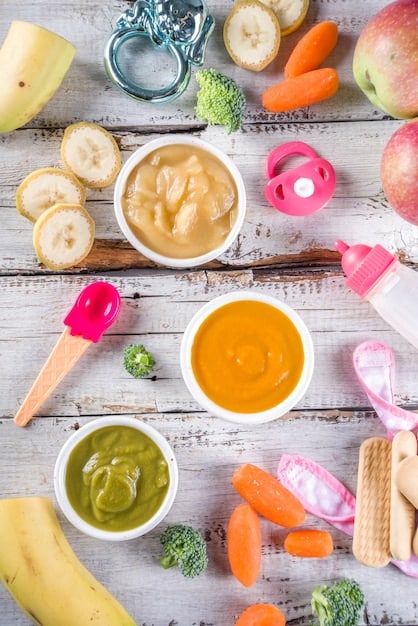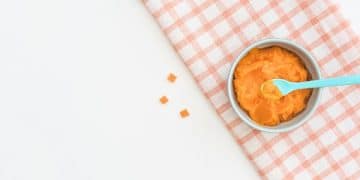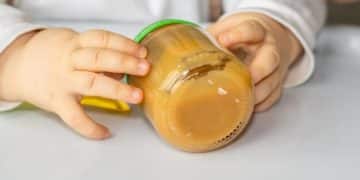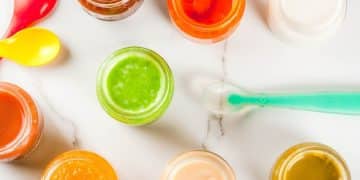Baby Food Pouches vs. Homemade: Nutrition Truths Revealed

Baby food pouches offer convenience, but when it comes to nutrition, homemade options often provide a more customizable and potentially nutrient-rich alternative, allowing parents to control ingredients and avoid added sugars or preservatives.
Navigating the world of baby food can be overwhelming for new parents. With countless options available, it’s essential to understand the nutritional value of each to make informed decisions. Let’s explore the truth about baby food pouches: are they as nutritious as homemade?
Convenience vs. Nutrition: Understanding Baby Food Options
When it comes to feeding your little one, convenience often plays a significant role in your choices. Baby food pouches have become a popular option for busy parents, offering a quick and easy way to provide meals and snacks. However, it’s crucial to consider the nutritional aspects of these pouches compared to homemade baby food.
Understanding the tradeoffs between convenience and nutritional content will help you make informed decisions that support your baby’s healthy development.
The Rise of Baby Food Pouches
Baby food pouches have surged in popularity over the past decade, largely due to their portability and ease of use. These pouches eliminate the need for jars, spoons, and extra containers, making them ideal for on-the-go feeding.
Homemade Baby Food: A Classic Approach
On the other hand, homemade baby food allows you to control every ingredient that goes into your baby’s meal. This can be particularly appealing to parents who want to avoid additives, preservatives, or unnecessary sugars.
- Ingredient Control: You choose exactly what your baby eats.
- Cost-Effective: Making your own baby food can be cheaper in the long run.
- Variety: Introducing a wide range of flavors and textures is easier.
Ultimately, understanding the pros and cons of each option will help you decide which approach best suits your family’s needs.
Decoding the Ingredients: What’s Really in Baby Food Pouches?
One of the primary concerns parents have about baby food pouches is the actual composition of the ingredients. It’s essential to scrutinize the labels and understand what’s actually in those seemingly innocent packages.
Carefully examining the ingredients list can reveal potential additives, preservatives, and nutritional content that might not be immediately apparent.

Reading the Label: A Guide for Parents
When evaluating baby food pouches, the nutrition label is your best friend. Pay close attention to the following:
- Sugar Content: Look for pouches with no added sugars. Fruits naturally contain sugar, but added sugars should be avoided.
- Preservatives: Check for artificial preservatives like BHA, BHT, or sodium benzoate.
- Nutrient Content: Compare the levels of vitamins, minerals, and fiber to ensure a balanced nutritional profile.
Common Additives and Preservatives to Watch Out For
Some baby food pouches may contain additives that are not ideal for your baby’s health. These can include:
Being vigilant about label reading ensures you’re providing your baby with the healthiest options possible.
Nutritional Breakdown: Pouches vs. Homemade
The nutritional value of baby food pouches versus homemade options is a critical factor to consider. While pouches offer convenience, they might not always provide the same level of nutrients as homemade food.
A comprehensive analysis of the nutritional content can help you determine which option offers the best benefits for your baby’s growth and development.
Key Nutrients: What Babies Need
Babies require a variety of nutrients to support their rapid growth and development, including:
- Vitamins: Essential for immune function and overall health.
- Minerals: Such as iron and calcium, crucial for bone development and blood health.
- Fiber: Aids in digestion and prevents constipation.
Vitamins and Minerals
Homemade baby food often contains higher levels of vitamins and minerals because the ingredients are fresh and unprocessed. Pouches, on the other hand, can lose some nutrients during the manufacturing process.

Fiber and Sugar
Homemade baby food allows you to control the amount of fiber and sugar in your baby’s diet. You can choose high-fiber ingredients and avoid adding any extra sugar. Pouches sometimes contain fruit purees that can increase the sugar content.
The Manufacturing Process: Impact on Nutritional Value
The way baby food pouches are manufactured can have a significant impact on their nutritional value. Understanding this process is crucial for making informed decisions about what you feed your baby.
High-pressure processing and heat sterilization, while ensuring safety, can degrade some of the vital nutrients present in the food.
High-Pressure Processing (HPP)
Many baby food pouches undergo High-Pressure Processing (HPP), a non-thermal pasteurization technique. While HPP kills harmful bacteria and extends shelf life, it can also reduce the levels of certain vitamins and enzymes.
In contrast, homemade baby food made with fresh ingredients retains its full nutritional value.
Heat Sterilization
Some pouches undergo heat sterilization, which also extends shelf life but can degrade heat-sensitive nutrients like Vitamin C. This is particularly concerning as Vitamin C is crucial for immune support.
By being aware of these manufacturing processes, you can better assess the nutritional trade-offs and make choices that prioritize your baby’s health.
Cost Comparison: Pouches vs. Homemade
When deciding between baby food pouches and homemade options, cost is inevitably a consideration. The expenses associated with each choice can vary significantly, influencing your decision-making process.
Assessing the long-term financial implications of both pouches and homemade food can help you determine the most economical and sustainable option for your family.
Initial Investment: Equipment and Ingredients
Initially, making your own baby food may require some investment in equipment like a food processor or blender. However, these tools can be used for various other cooking tasks as well.
Purchasing ingredients in bulk and utilizing seasonal produce can further reduce costs associated with homemade baby food.
Long-Term Savings
While the initial investment might be slightly higher, homemade baby food can save you money in the long run. Pouches can be quite expensive, especially if you rely on them exclusively.
By carefully evaluating both the initial expenses and long-term savings, you can determine the most budget-friendly approach to feeding your baby.
Practical Tips for Making Nutritious Choices
Making nutritious choices for your baby doesn’t always mean sacrificing convenience. There are practical steps you can take to ensure your baby gets the best of both worlds.
By implementing simple strategies, you can balance the convenience of pouches with the nutritional benefits of homemade food, ensuring your baby’s health and well-being.
Combining Pouches and Homemade Food
One approach is to combine the use of pouches with homemade food. Use pouches when you’re on the go and prepare homemade meals when you have more time. This can help ensure your baby receives a balanced diet without overwhelming your schedule.
Enhancing Pouches with Fresh Ingredients
Consider adding fresh ingredients to baby food pouches to boost their nutritional value. For example, you can mix a pouch of plain sweet potato puree with some freshly steamed broccoli or spinach.
- Read Labels Carefully: Prioritize pouches with minimal ingredients and no added sugars or preservatives.
- Variety is Key: Offer a wide range of fruits and vegetables to ensure a diverse nutrient intake.
- Trust Your Instincts: If you have any concerns about the ingredients or nutritional content of a pouch, opt for a homemade alternative.
By implementing these practical tips, you can confidently navigate the world of baby food and provide your baby with the best possible nutrition.
| Key Point | Brief Description |
|---|---|
| 🍎 Ingredient Control | Homemade food allows you to choose every ingredient. |
| 💰 Cost | Homemade can be cheaper long-term especially when buying in bulk. |
| ⏱️ Convenience | Pouches are incredibly convenient for on-the-go feeding. |
| 🔎 Label Reading | Check for sugars and preservatives. |
Frequently Asked Questions
▼
Yes, baby food pouches are generally safe. Ensure that the packaging is intact and that the product is within its expiration date. Always supervise your baby while they are eating from a pouch.
▼
Read the labels carefully to understand the nutrient content. Choose pouches that offer a balanced mix of fruits, vegetables, and whole grains. Supplement with fresh foods whenever possible for added nutrients.
▼
While pouches are convenient, it’s best to offer a variety of foods to your baby. Relying solely on pouches may limit their exposure to different textures and flavors, which is important for development.
▼
Look for pouches with simple, whole ingredients like fruits, vegetables, and grains. Avoid pouches with added sugars, salt, or artificial preservatives. Organic options are often a good choice.
▼
Yes, you can store homemade baby food in reusable pouches. Ensure the pouches are clean and BPA-free. Store them in the refrigerator for up to 48 hours or freeze them for longer storage.
Conclusion
While baby food pouches offer unmatched convenience for today’s busy parents, taking a closer look reveals that homemade baby food often holds a nutritional edge. With homemade options, you have full control over ingredients, ensuring your little one receives the freshest, most nutrient-rich meals possible. By being informed, reading labels carefully, and balancing pouches with homemade food, you can confidently nourish your baby with the best of both worlds.





